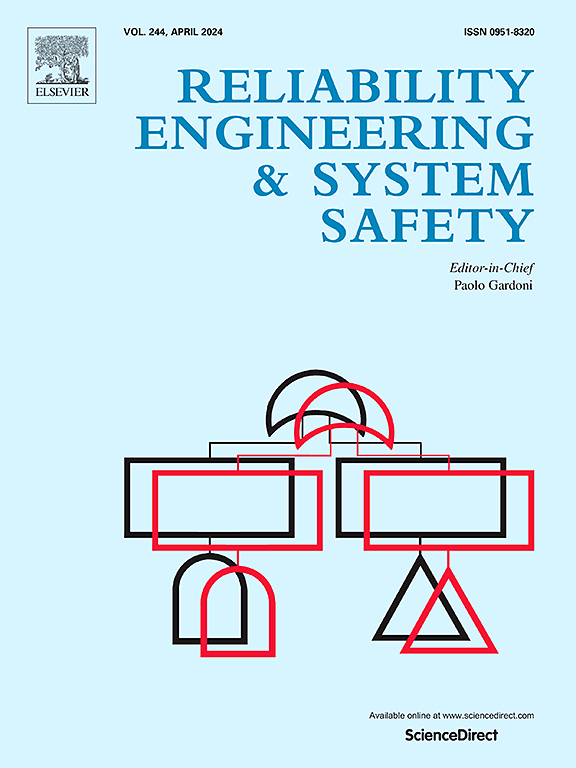A developed Fick's law and HSV-based fatigue reliability modeling method for CFRP/Epoxy adhesive structures considering environmental stresses and size effects
IF 11
1区 工程技术
Q1 ENGINEERING, INDUSTRIAL
引用次数: 0
Abstract
This manuscript, set against the backdrop of offshore wind turbine blades, focuses on the adhesive structure of carbon fiber and epoxy resin. By incorporating Fick's law and the High Stress Volume (HSV) method, a fatigue analysis and fatigue reliability modeling approach for adhesive structures under multi-environmental stresses, considering size effects, is proposed. This study applies Fick's law to analyze material moisture diffusion and assesses adhesive layer failure in aged samples. It develops a probabilistic fatigue life prediction model using the HSV method, delving into the fatigue degradation of adhesive structures. Through environmental aging and fatigue testing on CFRP/Epoxy adhesive structures revealed that extreme conditions of temperature, humidity, and salt fog expedite epoxy corrosion, diminishing load-bearing capacity and shortening the fatigue life. The study highlights that the aging environment, along with adhesive length and thickness, profoundly influence the performance of these structures. The model's predicted results have an average error of less than 5 % compared to experimental values, validating the feasibility of the proposed method. Furthermore, this research provides a theoretical basis for the life prediction and maintenance of offshore wind turbine blades.
建立了考虑环境应力和尺寸效应的CFRP/环氧胶粘剂结构的Fick定律和hsv疲劳可靠性建模方法
本文以海上风电叶片为背景,重点研究了碳纤维与环氧树脂的粘接结构。结合菲克定律和高应力体积(HSV)法,提出了考虑尺寸效应的粘接结构在多环境应力下的疲劳分析和疲劳可靠性建模方法。本研究应用菲克定律分析材料水分扩散,并对老化试样的粘接层破坏进行评估。应用HSV方法建立了粘接结构疲劳寿命概率预测模型,深入研究了粘接结构的疲劳退化问题。通过对CFRP/环氧胶粘剂结构的环境老化和疲劳试验表明,极端的温度、湿度和盐雾条件会加速环氧树脂的腐蚀,降低其承载能力,缩短其疲劳寿命。研究表明,老化环境以及胶粘剂的长度和厚度对这些结构的性能有着深刻的影响。模型预测结果与实验值的平均误差小于5%,验证了所提方法的可行性。为海上风电叶片的寿命预测和维护提供了理论依据。
本文章由计算机程序翻译,如有差异,请以英文原文为准。
求助全文
约1分钟内获得全文
求助全文
来源期刊

Reliability Engineering & System Safety
管理科学-工程:工业
CiteScore
15.20
自引率
39.50%
发文量
621
审稿时长
67 days
期刊介绍:
Elsevier publishes Reliability Engineering & System Safety in association with the European Safety and Reliability Association and the Safety Engineering and Risk Analysis Division. The international journal is devoted to developing and applying methods to enhance the safety and reliability of complex technological systems, like nuclear power plants, chemical plants, hazardous waste facilities, space systems, offshore and maritime systems, transportation systems, constructed infrastructure, and manufacturing plants. The journal normally publishes only articles that involve the analysis of substantive problems related to the reliability of complex systems or present techniques and/or theoretical results that have a discernable relationship to the solution of such problems. An important aim is to balance academic material and practical applications.
 求助内容:
求助内容: 应助结果提醒方式:
应助结果提醒方式:


